用于3d打印惯性和液滴微流体的加压光键。
IF 5.4
2区 工程技术
Q1 BIOCHEMICAL RESEARCH METHODS
引用次数: 0
摘要
微流体通过在小尺度上利用流体动力学改变了科学和工业应用,但制造技术的限制继续阻碍可扩展性和设计灵活性。本研究介绍了一种新的基于3d打印的制造方法,称为“压固化”,它可以使用市售的立体光刻打印机创建具有高分辨率,强键和耐溶剂性的微流体装置。通过对3d打印部件施加均匀的压力和紫外线固化,压固化方法可以在超过300 psi的压力下实现低于100微米的通道尺寸,坚固的粘合和结构保真度。我们通过几个微流体应用展示了该技术的多功能性,包括用于液滴生成的可扩展阶梯乳化剂,新月形颗粒制造和惯性聚焦喷嘴。压固化方法克服了PDMS和其他制造材料的传统限制,提供了增强的几何复杂性,机械稳健性和化学相容性。这种可访问且可扩展的方法扩展了微流体中增材制造的能力,为流式细胞术,微粒制造和基于液滴的分析等领域的创新设计铺平了道路。本文章由计算机程序翻译,如有差异,请以英文原文为准。
Pressurized photobonding for 3D-printed inertial and droplet microfluidics.
Microfluidics has transformed scientific and industrial applications by leveraging fluid dynamics at small scales, yet limitations in fabrication techniques continue to impede scalability and design flexibility. This study introduces a novel 3D-printing-based fabrication method, termed "press-cure", which enables the creation of microfluidic devices with high resolution, strong bonds, and solvent resistance using commercially available stereolithography printers. By applying uniform pressure and ultraviolet curing to 3D-printed components, the press-cure method achieves sub-100-micrometer channel dimensions, robust bonding, and structural fidelity under pressures exceeding 300 psi. We demonstrate the versatility of this technique through several microfluidic applications, including scalable step emulsifiers for droplet generation, crescent-shaped particle fabrication, and inertial focusing nozzles. The press-cure method overcomes conventional limitations of PDMS and other fabrication materials, offering enhanced geometric complexity, mechanical robustness, and chemical compatibility. This accessible and scalable approach expands the capabilities of additive manufacturing in microfluidics, paving the way for innovative designs in fields such as flow cytometry, microparticle fabrication, and droplet-based assays.
求助全文
通过发布文献求助,成功后即可免费获取论文全文。
去求助
来源期刊

Lab on a Chip
工程技术-化学综合
CiteScore
11.10
自引率
8.20%
发文量
434
审稿时长
2.6 months
期刊介绍:
Lab on a Chip is the premiere journal that publishes cutting-edge research in the field of miniaturization. By their very nature, microfluidic/nanofluidic/miniaturized systems are at the intersection of disciplines, spanning fundamental research to high-end application, which is reflected by the broad readership of the journal. Lab on a Chip publishes two types of papers on original research: full-length research papers and communications. Papers should demonstrate innovations, which can come from technical advancements or applications addressing pressing needs in globally important areas. The journal also publishes Comments, Reviews, and Perspectives.
 求助内容:
求助内容: 应助结果提醒方式:
应助结果提醒方式:


